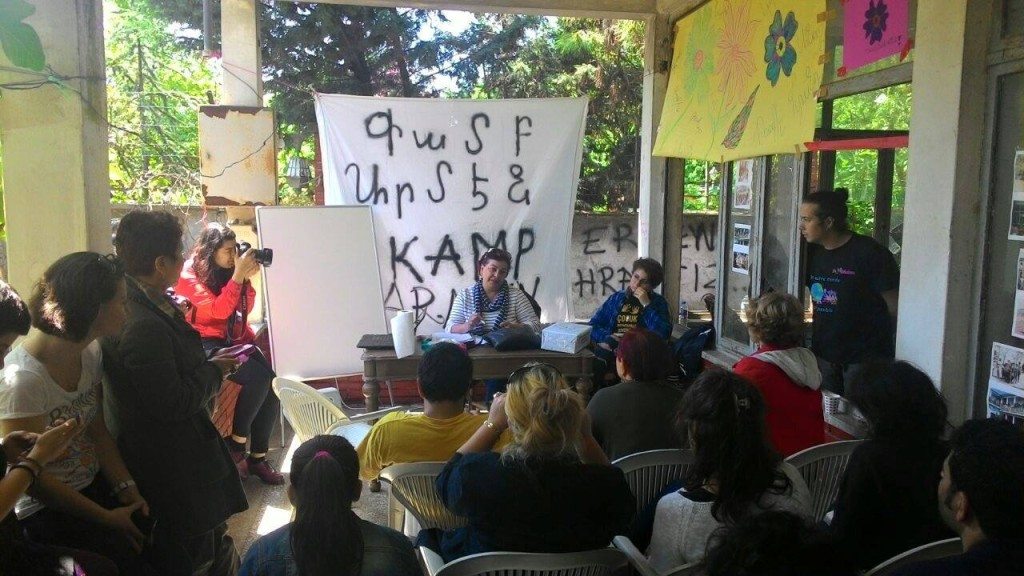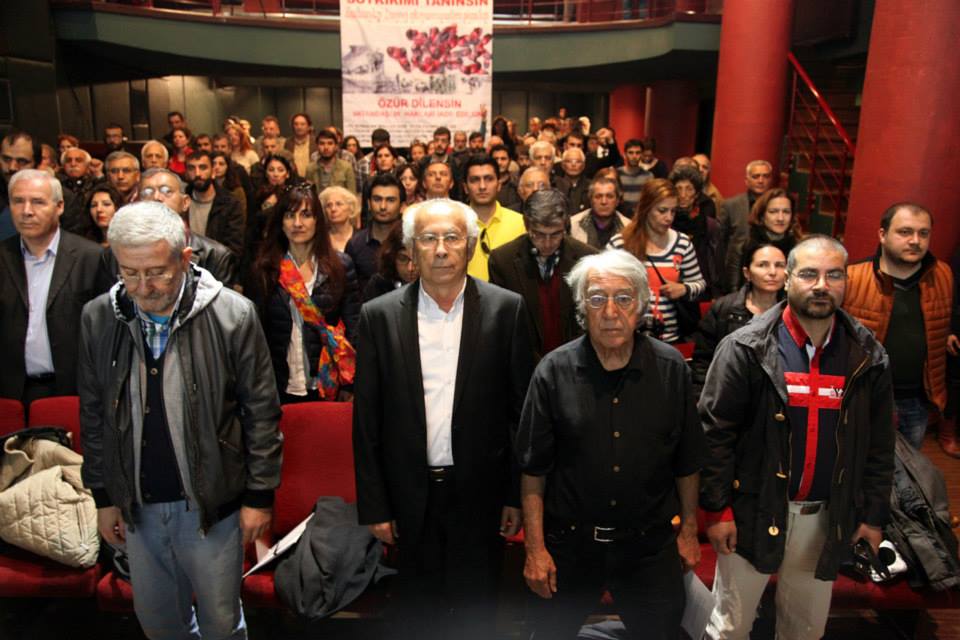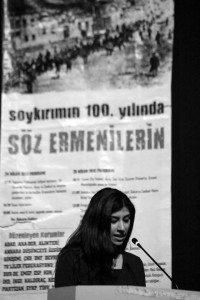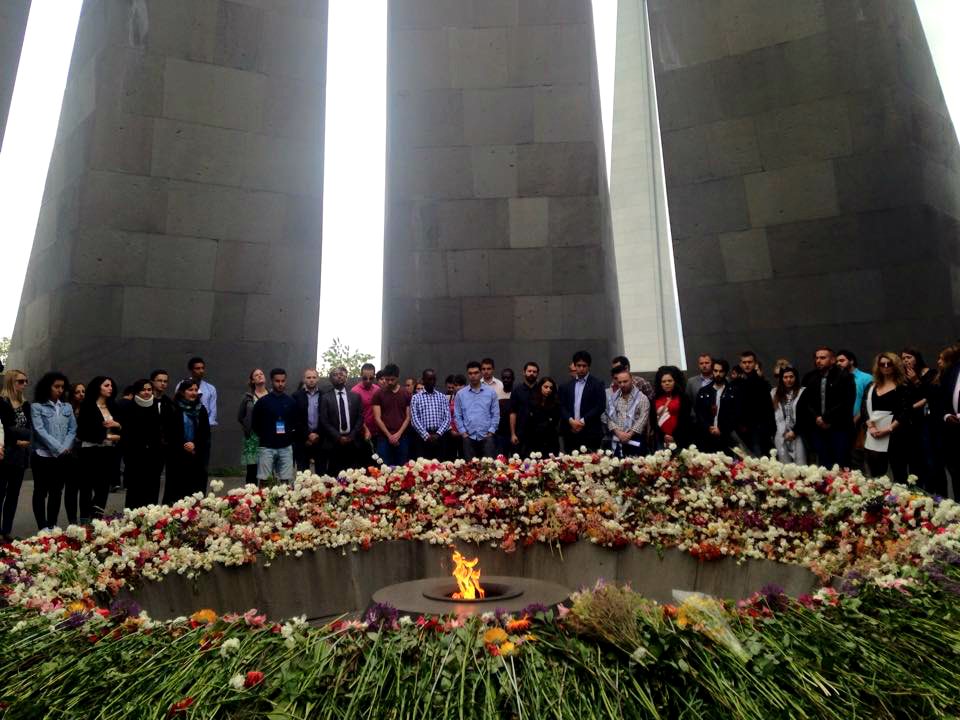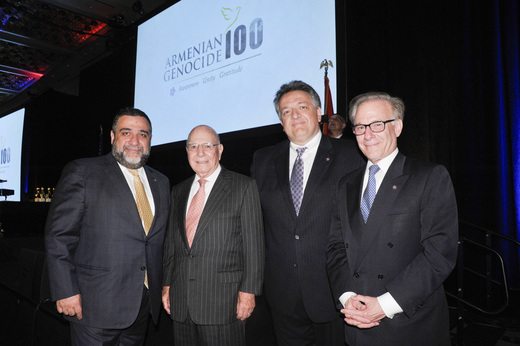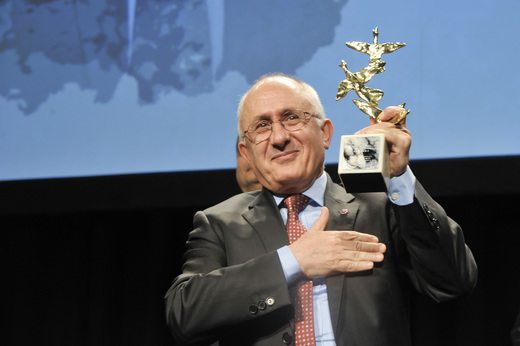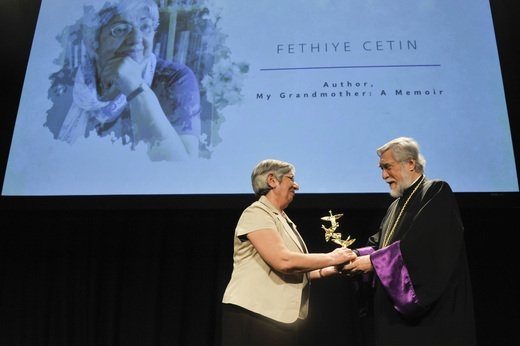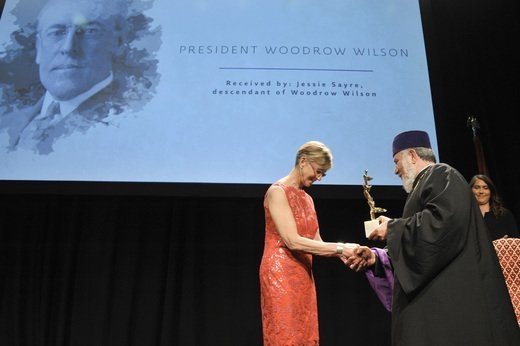This
paper is an expansion of remarks given by the author at McGill
University and the University of Toronto on March 18 and 20, 2015,
respectively.
There is an oft-repeated false truism about genocide, that denial is
the final stage of genocide. It is so unquestionably accepted that it
has even made its way into formal stage-theories of genocide. It is,
unfortunately, quite wrong. Denial is not the final stage of genocide,
but rather present throughout most of the genocidal process. When they
are doing it, perpetrators almost inevitably deny that what they are
doing is genocide. For instance, Talaat and his cronies were adamant
that their violence against Armenians was not one-sided mass
extermination, but instead a response to Armenian rebellion and violent
perfidy in Van and elsewhere. They maintained that the deportations were
intended to move Armenians to other areas of the empire, not a means of
destroying the Armenian population of village after village, town after
town.

The sky above the Armenian Cemetery of Diyarbakir (Photo: Scout Tufankjian)
We see variations on this theme in case after case. The United States
did not hunt down Native American groups, did not kill those under
their control or force them onto destructive reservations; no, my
country fought the so-called “savages” in a series of “Indian Wars.”
(One need only look at the historical record of hyper-violence by the
U.S. military and general population, which tortured, raped, killed, and
then mutilated Native Americans, to see who the real savages have
been.) The Tasmanians were killing livestock and even settlers, while
the Herero were in revolt. The Jews had a world conspiracy that was out
to get decent Aryans and needed to be stopped by the most brutal means
possible. Pro-democracy activists in Indonesia were actually a communist
insurgency, while Guatemalan Mayans, who appear to have been
hardworking people in dire poverty just trying to survive the assaults
on them by their government and country’s wealthy elite, were actually
communists determined to destroy the good values of their society and
impose a horrible political and social order. The Tutsi were hell-bent
on dominating the Hutu, who had no choice but to respond, and the
Bosnians Muslims, not Serbs were the aggressors, despite the fact that
the latter had by far more military power. Today, the supposed rebellion
in the Nuba Mountain and Blue Nile regions of Sudan leave “statesman”
Omar al-Bashir no choice but to bomb thousands of civilians with Antonov
aircraft.
Denial is not a stage of genocide, but part of the commission of
genocide, especially as prosecutions have led sophisticated perpetrators
to begin their international tribunal defenses while the blood is still
flowing.
Denial is not a stage of genocide, but part of the
commission of genocide, especially as prosecutions have led
sophisticated perpetrators to begin their international tribunal
defenses while the blood is still flowing.
Denial is certainly prevalent after genocide, as the false truism
does capture correctly. It is not a final stage, however. Indeed, as
long as denial persists, we can be sure that the genocidal process is
still operating. Denial accompanies this operation, and furthers its
goals of “eliminating the consequences” of the genocide for the
perpetrator group, even generations and centuries after the violence and
destruction. Denial is not the final stage of genocide; consolidation
of the genocide is.
1 A genocide is consolidated after the
phase of direct destruction—sometimes long after—when the perpetrator
group has made final and irrevocable all the various demographic,
political, identity, military, cultural, financial, territorial, and
other material and symbolic gains achieved through and deriving from the
genocide, when the post-genocide state of affairs has become
completely, utterly, and irremediably rendered permanent so that,
whether the victim group has faded out of existence or still somehow
persists, its condition will remain as it is, in the enduring position
of victimhood unredeemed and unrepaired. Denial, geopolitically
motivated treaties, and other influences all conspire with the passage
of time in the process of consolidation. What is striking about
consolidation is that, no matter to what extent complex forces can be
blamed for the direct phase of a genocide and leave room for repentance
by the perpetrator group, consolidation is done with a full
understanding of what was done through a genocide and the moral
obligation to repair that it has imposed, and in deliberate rejection by
the perpetrator group of somehow doing right by the victims.
A genocide deeply ruptures the pre-existing status quo and in
particular devastates the victim community. Just because the violence
and destruction of a genocide end does not mean that their consequences
are mitigated. On the contrary, so long as the impact of a genocide on
its victims remains unrepaired, that impact continues devastating them
in perpetuity. Despite the wishful thinking of philosophers such as
Jeremy Waldron, as Jermaine McCalpin has emphasized,
2 time
does not heal the wounds of genocide. On the contrary, as generation
follows generation, more and more people are injured, demeaned, and
assaulted by the original violence. With each day that passes without
repair, the scope of the destruction increases. The end limit point of
this process is not successful denial, but the point at which denial no
longer is necessary because the genocide’s impact has become fully
irreparable, as the genocide’s consequences become everlastingly secured
in the global social, political, and economic status quo. Denial ends
not with the success of denial, but the total and complete consolidation
of genocide. Genocides are denied because their effects—both material
and in terms of historical memory—are, thankfully, still contested.
Consolidation can happen through denial, at the point where denial has
erased the genocide completely enough that it will never rate
contemporary political and legal consideration, but it can also occur
when the genocide is fully known yet considered so far removed from
present concerns that its results are generally accepted.
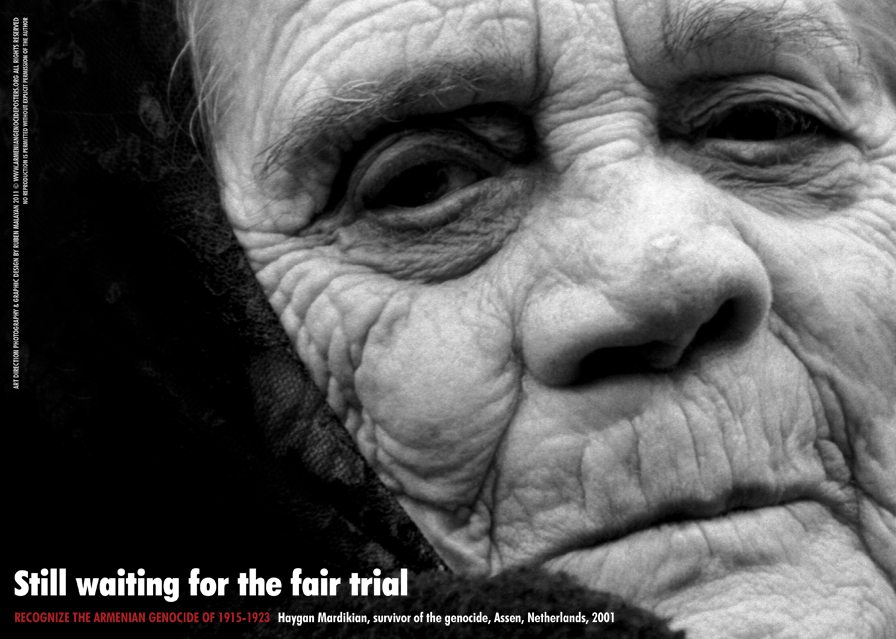
‘Still waiting for the fair trial’ (Design and photo: Ruben Malayan)
This is evident through a few examples. The genocides of the Herero,
Australian Aborigines, Native Canadians, and Native Americans are still
denied actively, precisely because the victim groups still experience
the impacts of the injuries of direct massacre, religious and cultural
destruction, internment on reservations, family degradation through
boarding schools and other forced transfers of children from their home
groups, and more, and so a reparative process could actually address
these harms. Denial stops reparations. Denial of the Holocaust continues
because the evils of anti-Semitism that it maximized horrifically
remain vibrant forces in human society across the globe; the Holocaust
persists through its legacy of making Jews, already considered fit
targets of oppression and violence, the fit targets of mass
extermination. Denials of the Bangladesh, East Timor, Cambodian, and
other cases continue because perpetrators and survivors yet live, and
the deep harm done to each society remains largely unaddressed. The list
of denied genocides goes on.
No one denies the genocides of Melos and Carthage, of the Cathars or
by Chengis Khan, because the destruction they imparted into the world
has long since been completely and irreparably incorporated into the
world order. For these and all too many other genocides, utterly and
completely “getting away with it” has been the final stage. How many
so-called great societies and states celebrated in the present and past
are so because of their complete success in consolidating the genocides
they committed?
The false truism reflects an important effect of denial. Years of
denial after a genocide actually skew the framework through which that
genocide is perceived and understood. Faced with a strong denial
campaign, survivors and concerned others, including in the perpetrator
group, find themselves in a seemingly endless, disheartening, degrading,
and exhausting struggle simply to get the truth recognized by enough
people that it will not be erased from the annals of human history. Soon
enough, the genocide itself is lost in the struggle against denial: The
struggle against denial becomes an end in itself. The defeat of denial
under such circumstances comes to be seen as justice for the genocide.
With this, defeated or not, denial wins the day, by preventing a victim
group from seeing that the defeat of denial does not give it justice,
but merely gets it back to the starting point from which a justice
process can finally be initiated. For long-past genocides, victim groups
and others forget that recognition of the genocide against denial does
not repair the harms done by the genocide, but merely addresses the
secondary problem of denial. Only by directly and substantially engaging
those harms through a comprehensive reparations process can the world
do what it can to bring justice to the victim group and all of humanity.
3
The recent attention on reparations for the Armenian case represents
an important move beyond focus on denial. With this in mind, it is clear
that 2015, the 100
th anniversary, should not be understood
as a culminating point in the post-genocide history of the Ottoman
Genocide of Christian Minority Groups. If recognition comes this year,
as it could—though I am not holding my breath—it will mean only that
finally, after a century, the victim groups and others concerned with
human rights can finally start addressing the harms done. But the
effects of genocide are not measured in such neat little packages of 10
years, 50 years, or 100 years, which we make special, after all, simply
because of the evolutionary accident that has given us 10 fingers to
count with. As much as some people, especially those outside of victim
communities who need a good story before they are willing to care about a
legacy of mass violence, attach significance to such time intervals,
the consequences of genocide play out in a complex history of material
and social causal chains so that no particular year or date has any
great actual meaning. Or, to put it more correctly,
every year and, indeed,
every day
in the long aftermath of a genocide have great importance, until the
injuries are addressed in a substantial way that is appropriately
transformative for both the victim and perpetrator groups.

Cover of the AGRSG Report on Reparations
Helping to accomplish this shift in focus toward repair has been the
Armenian Genocide Reparations Study Group (AGRSG), which in 2007 I
formed with renowned international lawyer and legal scholar Alfred de
Zayas, former Armenian Ambassador to Canada and treaty expert Ara
Papian, and dynamic Jamaican political scientist Jermaine McCalpin. The
AGRSG has done a comprehensive study of reparations for the Armenian
Genocide. The AGRSG Final Report
4 analyzes the harms done and
the legal, historical, and ethical justifications for repair, and then
proposes an innovative transitional justice process to effect it. The
report includes determinations of territorial and other restitution that
should be made by Turkey and discussion of the ways in which
reparations should be used by the Armenian group as a whole to ensure
the future viability of its state and its global identity.
The harms done by the Armenian Genocide are very much present today.
They include the dramatic demographic impact on the Armenian population
through direct and indirect killing as well as forced assimilation that
reduced the Armenian population of the Ottoman Empire to less than 40
percent of its pre-genocide number, but also the compounding impact on
birthrates and retention of members by rape and other torture; rampant
poverty; long-term effects of malnutrition; global dispersion; loss of
religious, educational, and other institutions necessary for the
cohesion of Armenian communities; and much more. To these harms are
added the extensive lost property of Armenians. Not only were virtually
all land, businesses, farms, warehouse inventories, food stocks, and
other such property taken from Armenians, but the mass expropriation
reached down to the most trivial items, from kitchen pots and pans to
the clothes on deportees’ backs and shoes on their feet. Turkish
activist and writer Temel Demirer has stated of this mass theft that it
was with this Armenian property that the national economy of the new
1923 Turkish Republic was founded.
5 What is more, since this
time, Armenians have lost all that would have been built on this wealth,
which compounds daily, with many living out their lives over the past
century impoverished because what was theirs was denied. And this mass
of material resources has not just disappeared: Wealthy Turkish
families, the government, and average people have received the
cumulative benefits of all that this wealth has allowed them to build,
its daily compounding interest. In fact, scholars such as Uğur Ümit
Üngör and Mehmet Polatel have traced expropriated Armenian property
right through to contemporary national and regional elite families, some
of whose family fortunes were built with the property pilfered from
exterminated Armenians.
6
The destruction of religious, educational, cultural and artistic, and
other aspects of Armenian communal existence, coupled with demographic
collapse and global dispersion, have rendered Armenian identity and
peoplehood fragile, requiring continual, draining efforts by members of
the community just to prevent their erasure. The demographic destruction
and individual as well as state territorial expropriations of the
1915-23 period are the most important factor in the verity that today’s
Armenian Republic is a small, landlocked country of barely 3 million
facing a gigantic, economically and militarily powerful Turkey of 70
million—a hostile Turkey that enjoys tremendous regional power and
geopolitical prominence that allows it nearly free reign in its
treatment of the Armenian Republic. Even had the genocide occurred but
Ataturk’s ultra-nationalist forces not invaded and conquered the bulk of
the 1918 Armenian Republic, historian Richard Hovannisian has estimated
that the Armenian Republic today would be a much larger and secure
state with a population on the order of 20 million.
7 What
would it mean for such an Armenia to face a territorially and
demographically smaller Turkey today? Surely Armenians in the republic
and around the world would be infinitely more secure and enjoy a level
of community well-being that became a fantasy on April 24, 1915.
Armenians in Turkey have borne a great share of the genocide’s
impact. After almost a century of suffering in relative silence, the
legacy of oppression and violence is now well known. Reflecting on
Native Americans in the United States, Mayans in Guatemala, survivors of
childhood sexual abuse, and other such groups, it seems clear that the
most difficult situation a victim group or individual can find itself,
himself, or herself in—even beyond the terrible situation of all
victims—is to remain subject to the perpetrator group or individual. Far
beyond the painful, demeaning effects of denial for a group that has
escaped, the situation of those still under perpetrator hegemony is to
be constantly forced to live within the world of violence and power of
the original harm, feeling always on the edge of being pushed back into
the violence, with no escape from the terror, nor space simply to mourn
what happened. And perpetrator groups and individuals seem never content
even with that level of continuing harm to their victims but, as we
have seen with Turkey, continue with such things as repression of
non-Muslim minority foundations and expropriation of their property
8 and the assassination of Hrant Dink.
Reparations for the Armenian Genocide are certainly legally,
historically, and morally justified in abstract terms. But, as the
Armenian Republic struggles economically and politically, the Armenian
Diaspora expends greater and greater energy to be less and less
effective in preserving Armenian identity, and Armenians in Turkey
continue to live under threat and oppression, reparations are an
absolute need if the Armenian Republic, the Armenian Diaspora, and the
Turkish-Armenian community have any future at all, and the 1915 genocide
is not to succeed by 2065. The current trends make it a real
possibility that the state will fail in the next half century, the
Armenian-Turkish community will become a perpetually subjugated group
with no hope of true participation as full citizens in their state and
its society, and Armenian identity will become a residual and decaying
aftereffect of genocide, rather than the vibrant, living community
anchor it should be.
The full history of the Armenian Genocide is far from written.
Coupled with this analysis of the need for reparations, it is useful
to consider some of the standard objections raised against reparations
in a case such as the Armenian Genocide. First, another false truism is
that time heals all wounds. Nothing could be more wrong, unless by
healing we mean that perpetrator groups and the world in general
eventually can forget about a past genocide when the victim group
finally fades away in the ultimate triumph of genocide. Unless the harms
of a genocide are addressed, then they persist and in fact compound
over time, with each generation of the victim group grappling with them.
[A]nother false truism is that time heals all wounds.
Nothing could be more wrong, unless by healing we mean that perpetrator
groups and the world in general eventually can forget about a past
genocide when the victim group finally fades away in the ultimate
triumph of genocide. Unless the harms of a genocide are addressed, then
they persist and in fact compound over time, with each generation of the
victim group grappling with them.
If time is running out, it is running out for the perpetrator groups.
As Armenians, Assyrians, and Greeks join what I will call the “100-plus
Club” of groups whose experience of destruction has endured for more
than a century, it is Turkey that should regard the sands flowing down
in the hourglass with foreboding and disquiet. As time passes, harms
become more difficult to repair, and those in the victim communities who
have lived and died without justice can never receive it. Already Japan
is on the verge of failing utterly to repair in any way at all the
harms done to the Comfort Women—actually, many if not most were underage
girls—whom its military government subjected to brutal sexual
enslavement in the 1931-45 period. These girls and women were interned
in hellish stations and raped sometimes 30 times a day, 6 days a week,
for months and even years. Many died, but those who survived have for a
quarter century demanded an apology and meaningful atonement through
material reparations (necessary for such things as their medical bills
as they deal with the life-long effects of their horrific captivity,
often without children helping them because of the hysterectomies forced
on them). Japan has refused and denied, and now many former Comfort
Women have passed on. Japan has already lost the opportunity with them,
and as a state and society must bear the taint of this terrible human
rights abuse as long as it continues to exist. And once the last former
Comfort Woman is gone, the taint will be complete. I have termed this
kind of impact an “impossible harm.”
9
Turkey and other such perpetrators have the benefit that national,
ethnic, racial, and religious groups, if they survive attempted
annihilation, have identity cohesion over time, and so as long as
genocide does not succeed completely, there is always a group that can
receive efforts at repair. Of course, Turkey has already irrevocably
lost its greatest opportunity to repair the harm to survivors and
itself, as there are virtually no direct survivors of the genocide alive
today. There is no longer anything to be done about this intentionally
lost chance. But much can still be done. Unfortunately, with each
passing day the harm grows and there are more and more members of the
victim group who have lived and died without repair and who thus
represent a growing permanent taint for the perpetrator state and
society. Not only have Turkey and states and societies like it so far
failed to do right by Armenians, Assyrians, and Greeks, and other victim
groups, respectively, but they are failing their own future generations
by imposing on them the stigma of a more and more irreparable genocide.
Second, even setting aside the legal status of Turkey as the Ottoman
Empire’s continuing state and Turkish Republican forces’ perpetration of
the second phase of the Armenian Genocide from 1919 to 1923, Turks in
the Turkish Republic today do bear responsibility for addressing the
harms of the genocide. They are not in any way to blame for it,
10
even when they deny it (though they are separately culpable for
denial). But, as their state and society continue to hold the gains made
and to benefit from them, and Armenians continue to suffer from the
material, political, and identity losses sustained, today’s Turks have
an obligation to repair the damage as much as possible. Of course,
nothing approaching full repair is possible: They cannot bring back the
dead, nor can they turn back the denial clock to erase all the damage
done as the harms to Armenians who have lived and died have compounded
for a century. But, as the AGRSG Report lays out, significant symbolic
and material reparations are very possible today; they require only the
political and ethical will to make them. Making them is not unfair to
present-day Turks. This is not a burden forced on them by Armenians, who
should just go away quietly. On the contrary, the burden of genocide
has been forced on present-day Turks and Armenians by the perpetrators
of the genocide, who damned their progeny to the moral taint of genocide
for this past century and beyond. However extensive a reparations
package is made by Turks today, the burden they assume in giving
reparations is the barest tiny fraction of the burden of loss and
suffering the genocide still imposes on Armenians. The push for
reparations is asking Turks today to shoulder just a small part of the
burden borne by Armenians, to share just a part of the unfairness
history has imposed. If this is a sacrifice for Turks today, this is
appropriate: Such a sacrifice confirms the true rehabilitation of the
Turkish state and society, which were formed in part by the many
genocide perpetrators in the Turkish Republic’s government and military,
and which have retained deep within their political culture the same
genocidal attitudes toward past victims as drove genocide in the first
place. Reparations are necessary for the rehabilitation of the Turkish
state and society, as surely the Kurds and those residual Armenian and
other communities in Turkey could attest.
[A]s the AGRSG Report lays out, significant symbolic and
material reparations are very possible today; they require only the
political and ethical will to make them. Making them is not unfair to
present-day Turks. This is not a burden forced on them by Armenians, who
should just go away quietly. On the contrary, the burden of genocide
has been forced on present-day Turks and Armenians by the perpetrators
of the genocide, who damned their progeny to the moral taint of genocide
for this past century and beyond.
Even a substantial territorial return to the Armenian Republic, which
seems to cause an existential crisis for some Turks, is not an absurdly
irrational imposition. How dare, many Turks say or think, Armenians
demand
Turkish land? But that very thought betrays the problem.
This land became Turkish through the genocidal ideology that
depopulated it of Armenians. Holding that land against what is right
means holding on to that genocidal ideology. That is why land
reparations are crucial for Turkey’s rehabilitation away from genocide.
Another objection is that the quest for reparations, particularly
territorial, is a hopeless pipedream kept alive by deluded so-called
“Armenian nationalists” who refuse to live in reality. Realpolitik is
the dominant ethic of international relations, and it leaves no room for
moral imperatives toward repair. Armenians are too weak to compel
reparations, and should focus on what is actually possible. What is
more, international law, however much based on the principle that harms
should be repaired, simply does not have the legal and procedural
mechanisms to deal with the Armenian and other long-standing cases. As
the perpetrator groups have held out for so long, they have in fact made
law irrelevant. And even where laws and procedures are available,
domestic courts usually want no part of such overarching concerns, and
international courts are subject to a range of political forces that
bring the matter back to realpolitik again. Wherever victim groups such
as Armenians turn, the situation seems hopeless.
How dare, many Turks say or think, Armenians demand Turkish
land? But that very thought betrays the problem. This land became
Turkish through the genocidal ideology that depopulated it of Armenians.
Holding that land against what is right means holding on to that
genocidal ideology. That is why land reparations are crucial for
Turkey’s rehabilitation away from genocide.
This is just what those who know that their power rests on genocide
and oppression want them to think. Again and again victim groups,
oppressed groups, are told that there is no hope, that they have no
power, that realpolitik trumps morality every time. Why do the powerful
say this? Because they know that to hold their power and ill-gotten
gains, they must convince their victims to believe it. For, once victim
groups believe that nothing can change, nothing will change. We must be
thankful that slaves and abolitionists in the United States and around
the Western world did not believe that the system of slavery of Africans
was inevitable and would not fall. Surely countless slave holders in
the U.S. South made this claim in 1855, only to see the end of slavery
within the decade. And their descendants said the same thing about
segregation, but Martin Luther King, Jr., Malcolm X, and millions of
others refused to believe it and continued pressing, until the world did
change. Surely Gandhi was told in 1935 that decolonization was a
useless pipe dream, and thankfully he refused to bow to such an
oppressive “reality.” Nothing in the world is given, and as much as
human history is filled with genocide and oppression, it is filled with
the efforts of those who oppose and overcome it. However much we might
debate the nature of “justice” as a philosophical context, divergent
ethical theories all seem to agree that causing others to suffer is
wrong and imposes an obligation to help those caused to suffer. Rather
than succumbing to the apparent limits of politics and law, if they do
not allow justice (though from ancient times promotion of justice has
been their sole validation), then we must transform politics and rewrite
the law. Politics and law must conform to genuine justice, not dictate
to humanity some stunted, anemic shadow of the just.
The examples of King, Gandhi, and others suggest something else we
should consider. I have written before about the importance of group
reparations for such peoples as Armenians, over individual reparations,
which do not contribute to the rebuilding and reconstitution of the
people as a whole.
11 But now I would like to push these ideas
further. The current reality we live in across the globe is a world
order formed through the forces of aggressive war, colonialism, slavery,
apartheid, economic exploitation, mass rape and sexism, and, of course,
genocide.
It might be said that, because the deep-reaching forces of
destructive change have been so dramatic and blatant, and their result
so often absences that mean there is nothing to see, the denial process
inherent in human political arrangements and societies has led us all
the more readily to miss the impact of the past on the present. Benedict
Anderson might have highlighted the process by which what became
nations in Europe and elsewhere were built through a linguistic and
conceptual homogenizing process,
12 but as Ernst Renan
explained a century before him, this process of nation formation is
accomplished through a long period of destruction that can include both
the physical elimination of divergent populations and the cultural
destruction of competing language, ethnic, and other groups.
13 Let us not forget that the Christianization of Armenians in the 4
th
Century of the Common Era was accomplished through the rampant and now
quite regrettable destruction of the religion, culture, and art of the
paganism that existed before. To recognize the forces of destructive
change that have made the reality we inhabit is not very hard once we
know that we are looking for incongruous presences and bright, shining
absences. Consider Europe, for instance, with its multitude of cultures;
languages; political arrangements; great philosophical, literary, and
artistic traditions; and cuisines. Yet, in the midst of our gaze, a
nagging twinge at the edge of consciousness and history becomes a full
question: Where are the Jews? To answer in Israel or the United States,
Canada, or elsewhere begs the question. A conglomerate of groups sharing
a religion and sense of identity in areas from Russia to France, this
group was a central part of the very fabric of European identity and
society for a millennium, but now they are largely gone relative to that
prior presence, their great contributions erased through centuries-ago
expulsions from England, forced conversions in Spain, pogroms in Russia,
and more, and then, of course, the maximal moment of anti-Semitic
destruction continent-wide, the Holocaust. The world we have today is
the product of this treatment of the Jews.
The absence of European Jewry is inverted in the presence of African
Americans in the United States. They are there every day, in the highest
echelons of celebrityhood, politics, and business, but also in the
great ghettoes that punctuate major and minor U.S. cities, in the U.S.
prison system that incarcerates more people than the rest of world
combined, and in the anxieties of polite white society. How many
thousands of hours of political talk shows and academic and government
reports try to sort out why the majority of African Americans are in a
place of rampant poverty and violence. Why is such a high percentage of
Blacks poor? The answer seems so complex that it is unanswerable. But is
it? Perhaps I betray the simple limits of my mind by pointing out what
seems obvious, but is not Black poverty the direct result of slavery and
Jim Crow segregation and discrimination, or more exactly the fact that
the extreme damage done by both has never been repaired? The release of
slaves followed generations of legally and violently imposed illiteracy
and educational exclusion; of family destruction, torture, rape, and
degradation that materially undermined and psychologically traumatized
the population; and the loss of 250 years of extorted free labor to
build the Colonies and then the United States. While for a brief moment
during reconstruction some small repair was made, in the form of the
land necessary for former slaves to become working-class citizens, the
40 acres and mule were quickly repossessed by Uncle Sam and the slave
owners then compensated for the loss of
their property—their
property.
The vast majority of African Americans were plugged into the already
genuinely inhospitable capitalist economy of the United States without
capital, training or education, or full recognition as human beings. Is
it any wonder they started poor? That they stayed poor? Despite some
upward (and downward) mobility in the United States, class is generally
constant across generations, for the simple reason of inheritance. Those
with money give it to their offspring, who are plugged into the economy
with property, while those without it have nothing to offer their
children, who end up at the same low level as their parents, and
grandparents, and great-grandparents. Add to this the powerful
exclusions and discriminations of Jim Crow, which kept Blacks from
joining the various Caucasian immigrant groups in their upward economic
climb and took away whatever they were able to get, to keep them right
where they always had been, and Black poverty today is not just
explicable, but inevitable.
While setting right each instance of such a historical wrong is a
step in the right direction, this approach to reparations is not simply
an aggregation of cases by single groups. Reparations is the process of
global transformation through which we can finally begin to rework our
world away from the structures resulting from genocide and all these
other destructive, terrible forces, toward a vision in which all human
beings have dignity and enough to eat, in which all people can live free
from violence and degradation. “Solidarity” in its true sense is not
just recognizing the similarity of experiences and struggles and lining
up different groups together in a mutual support network. It is built on
recognition that victim groups are together in a single, unified,
shared world formed by genocide, slavery, imperialism, and so on, and
that, at the deepest level, they face a common force of oppression and
destruction that must be addressed as a whole if the local success of
one group will not be cynically balanced by a shift in the structure
that will mean victimization of other groups. The problem is so big and
individual groups’ parts so interwoven that it can only be solved for
each group through a coordinated global approach. As each specific group
pursues justice against the legacy of mass violence and oppression it
has experienced, it must do so in a way that resonates with and promotes
every other group in the struggle for justice across the world.
Explained this way, the task ahead surely appears daunting. If the
world has taken more than half a millennium to become what it is today,
it is a given that such a broad transformation will not happen overnight
through some fantasy of revolution. Fortunately, in the past decade,
there has emerged a global reparations movement. Jews, Hereros, African
Americans, indigenous North and South Americans, Aborigines, South
African Blacks, former Comfort Women, Assyrians, Greeks, a host of other
groups, and, yes, Armenians are more and more recognizing their common
cause and working toward the great goal of a repaired world. However
long it will take, if we are committed to a truly just and good world
order, we must all actively participate this struggle.
Notes
[1] This concept and approach are first introduced in Henry C.
Theriault, “Denial of Ongoing Atrocities as a Rationale for Not
Attempting to Prevent or Intervene,” in Samuel Totten (ed.),
Impediments to the Prevention and Intervention of Genocide: A Critical Bibliographic Review.
“Genocide: A Critical Bibliographic Review” book series, Vol. 9 (New
Brunswick, NJ, USA: Transaction Publishers, 2013). pp. 47-75.
2 Jermaine O. McCalpin, “Reparations and the Politics of Avoidance in America,”
The Armenian Review 53:1-4 (2012): 11-32.
3 This line of argument is developed in Henry C. Theriault, “From
Unfair to Shared Burden: The Armenian Genocide’s Outstanding Damage and
the Complexities of Repair,”
The Armenian Review 53:1-4 (2012): 121-166.
4 The full report is available at www.armeniangenocidereparations.info.
5 Temel Demirer, presentation, “The ‘Armenian Issue’: What Is and How
It Is to Be Done?” panel, “1915 within Its Pre- and Post-historical
Periods: Denial and Confrontation” symposium, Ankara, Turkey, April 25,
2010.
6 Uğur Ümit Üngör and Mehmet Polatel,
Confiscation and Destruction: The Young Turk Seizure of Armenian Property (London, UK: Continuum International Publishing Group, 2011).
7 Richard G. Hovannisian, public lecture, Armenian Relief Society Armenian Summer Studies Program,
Amherst College, July 1991.
8 Sait Ҫetinoğlu, “Foundations of Non-Muslim Communities: The Last Object of Confiscation,”
International Criminal Law Review 14:2 (2014): 396-406.
9 Henry C. Theriault, “Repairing the Irreparable: ‘Impossible’ Harms
and the Complexities of ‘Justice,’” in José Luis Lanata (ed.),
Prácticas Genocidas y Violencia Estatal: en Perspectiva Transdiscipinar (San Carlos de Bariloche, Argentina: IIDyPCa-CONICET-UNRN, 2014), pp. 182-215.
[1]
0 This distinction is informed by George Sher’s
treatment of the difference between “blame” and “responsibility” in
“Blame for Traits,” plenary address, 28th Conference on Value Inquiry,
Lamar University, Beaumont, TX, USA, April 14, 2000.
[1]
1 Henry C. Theriault, “Reparations for Genocide: Group Harm and the Limits of Liberal Individualism,”
International Criminal Law Review 14:2 (2014): 441-469.
[1]
2 Benedict Anderson,
Imagined Communities: Reflections on the Origin and Spread of Nationalism, rev. ed. (London, UK: Verso-New Left Books, 1991).
[1]
3 Ernest Renan, “What Is a Nation?”, Martin Thom (trans.), in Homi K. Bhabha (ed.),
Nation and Narration (New York, NY, USA: Routledge, 1990), pp. 8-22.
